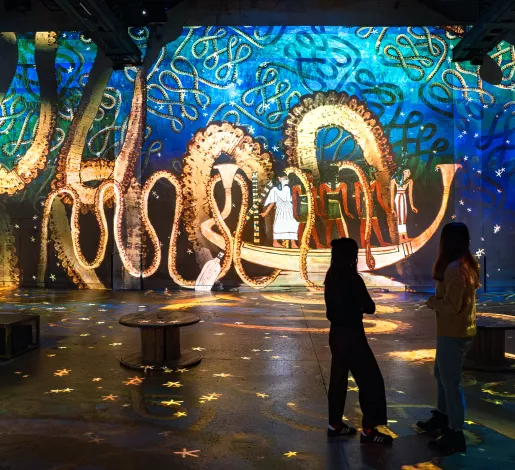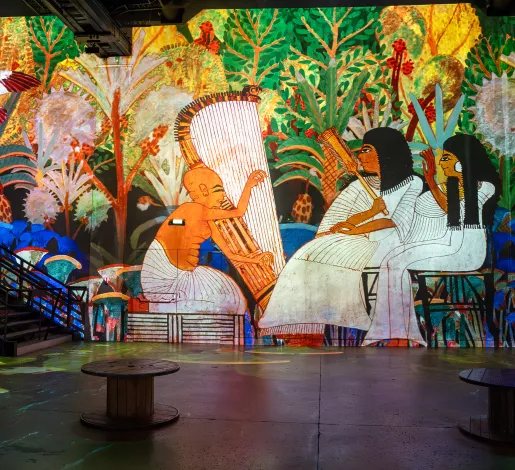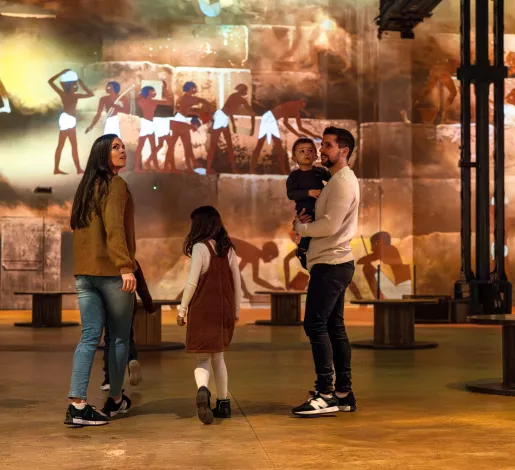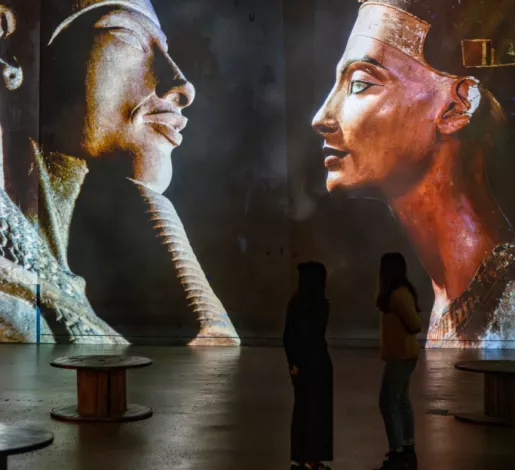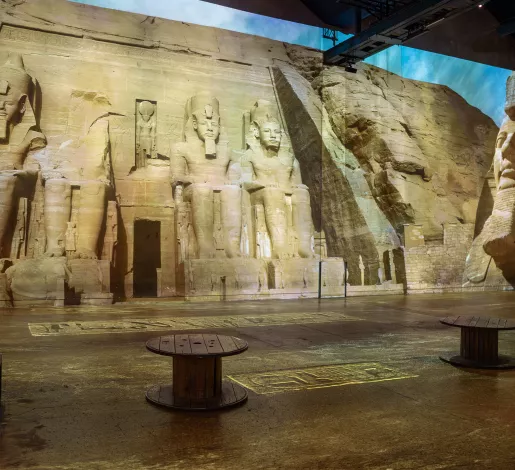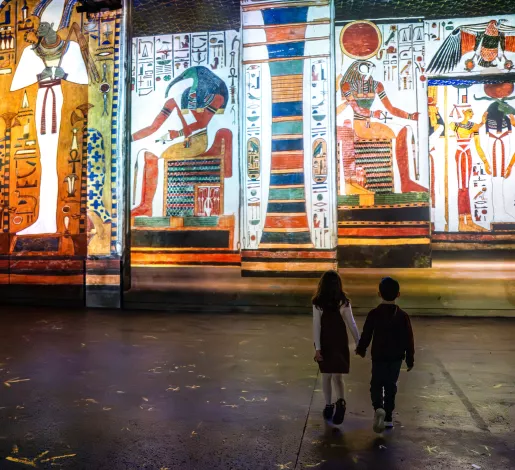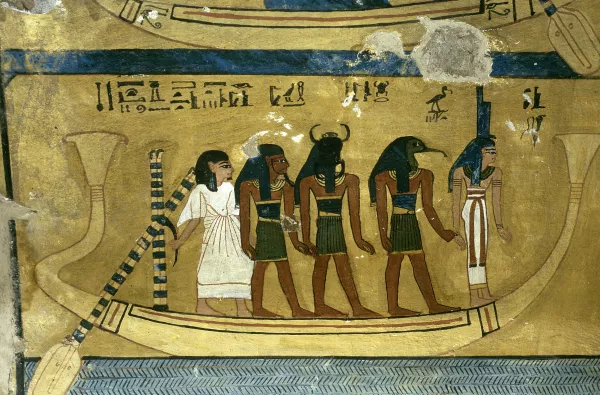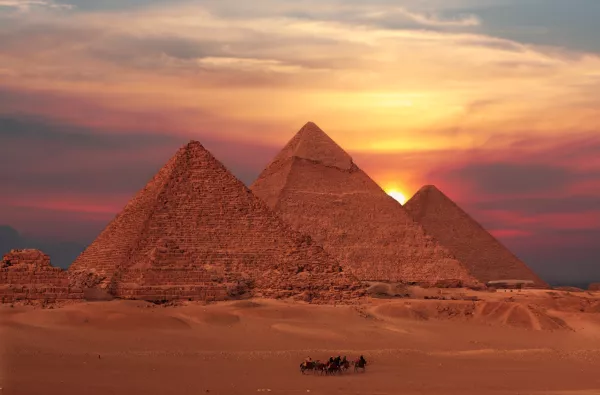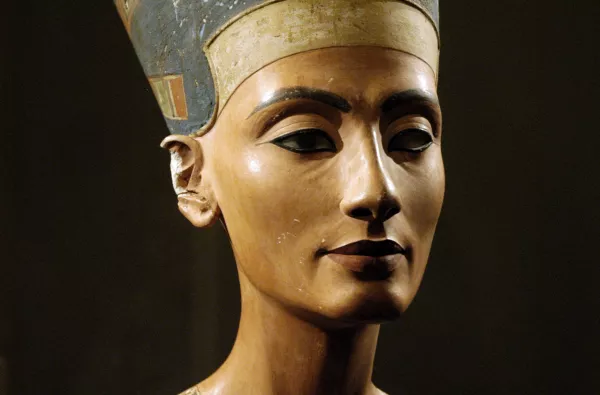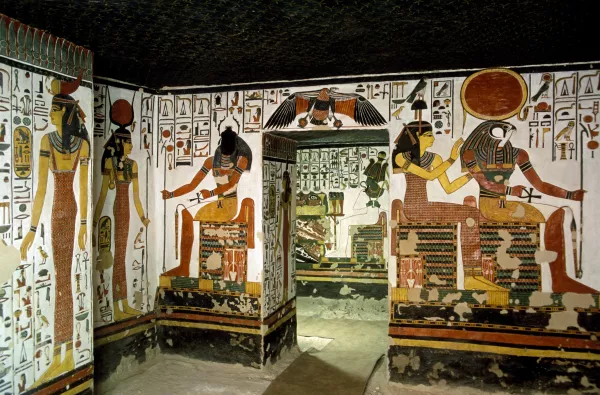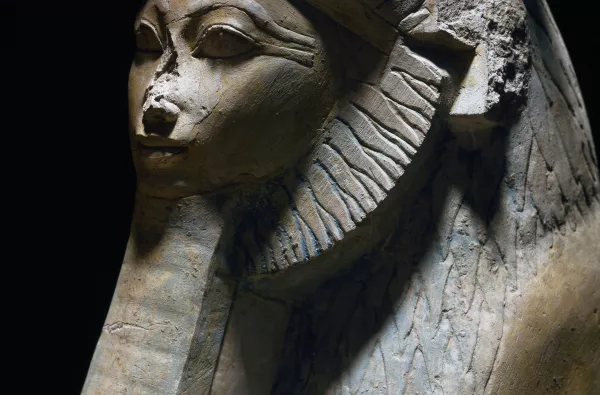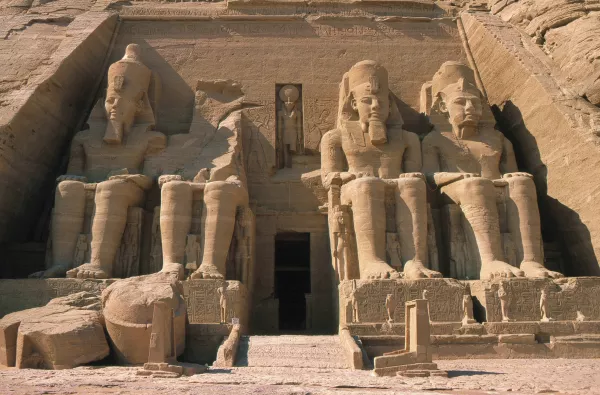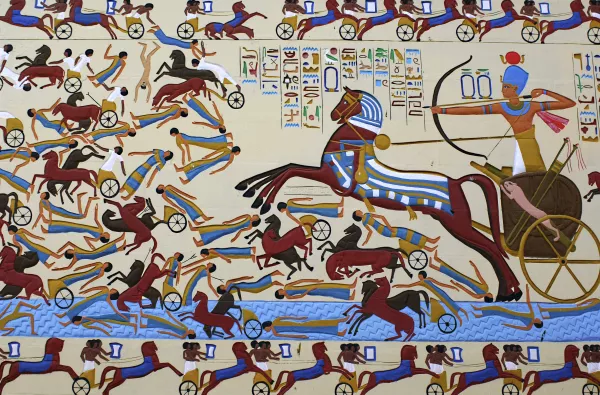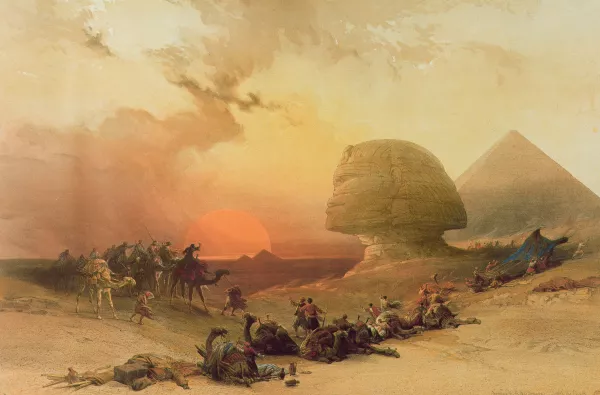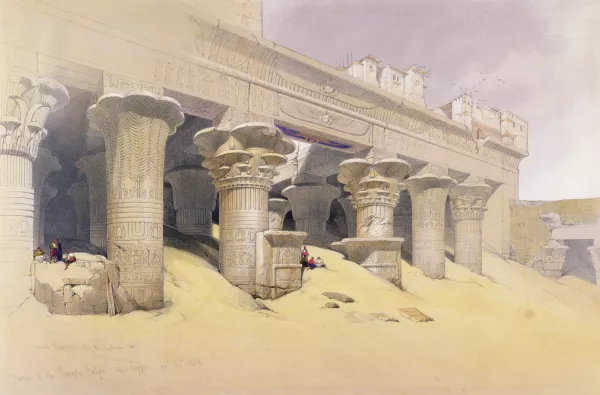From April 11 to 27, The Little Prince is on every day. Picasso will come back on Mondays & Sundays from April 28.
About the exhibition Egyptian Pharaohs
Ancient Egypt, a 3000-year history
Key works
Click on a work to find out more.
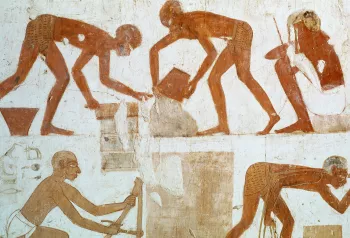
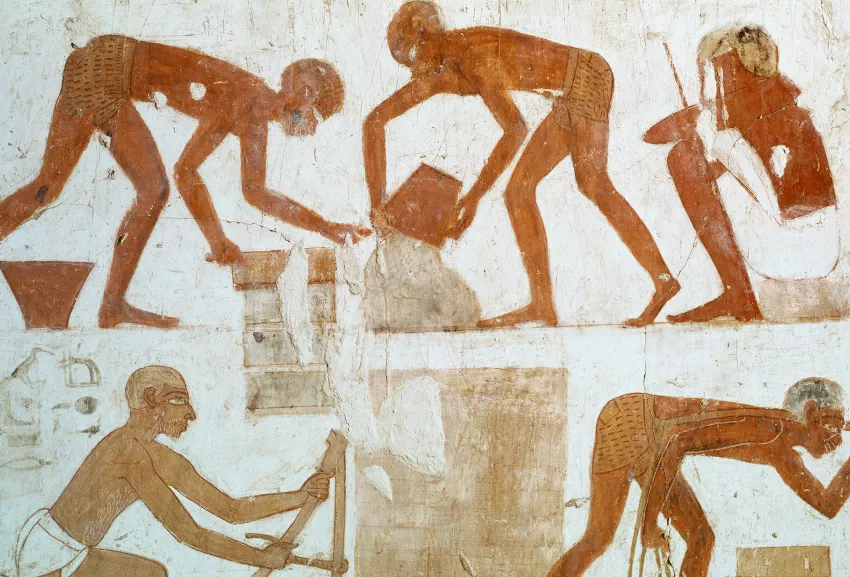
Workers on the construction of a temple, detail from the mural fresco in the tomb of Rekhmire, vizier under Thutmose II and Amenhotep II, circa 1450-1350 BC, Valley of the Nobles, Sheikh Abd el-Gournah
Workers on the construction of a temple
A sort of prime minister, the vizier headed the Egyptian administration, second only to the pharaoh. His responsibilities were considerable: he appointed civil servants, supervised agricultural production, taxes, river transport and construction sites. He was also chief of police and justice. No wonder, then, that the tomb of Rekhmire, vizier between 1450 and 1350 BC, was built in the Valley of the Nobles, a mountain that contains the tombs of pharaohs' closest relatives. Rekhmire remained in the service of Thutmose II for 20 years, a service renewed by his successor Amenhotep II.
Workers on the construction of a temple
detail from the mural fresco in the tomb of Rekhmire, vizier under Thutmose II and Amenhotep II , circa 1450-1350 BC , Valley of the Nobles, Sheikh Abd el-Gournah , © akg-images / André Held
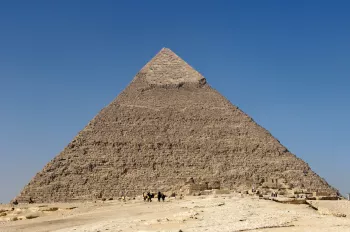
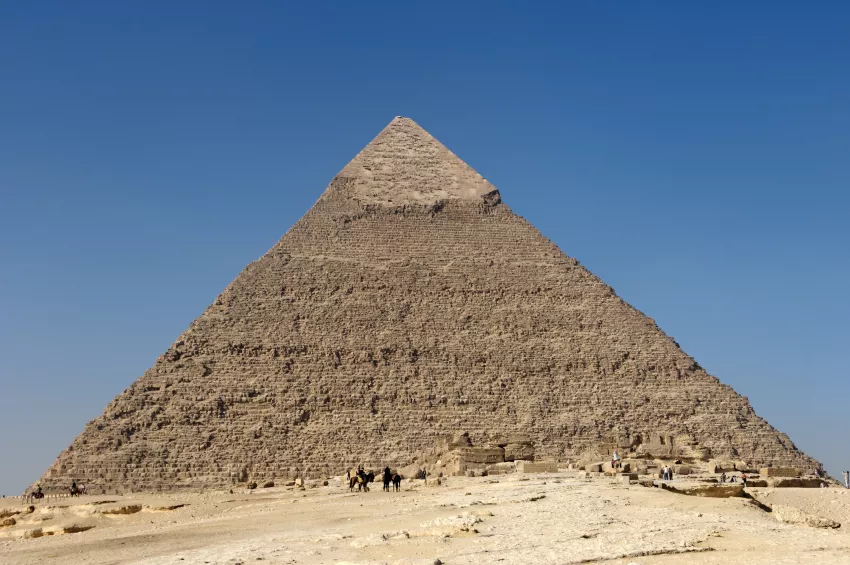
The Pyramid of Khafre, son of Cheops, built around 2570 BC, Giza
The Pyramid of Khafre
What hasn't been written about the pyramids of Giza? No monument has elicited as much fascination as these three tombs. Prodigious masses of stone now 4,500 years old, these titanic tombs were built for the Pharaohs Khufu, his son Khafre, and his grandson Menkaure. It is said to have taken 20 years and over 20,000 workers, at a rate of one block placed every two minutes, to build the largest of all pyramids, the Great Pyramid of Giza (Khufu’s tomb). From the outset, the pyramids were designed to last forever, right down to the walls of their temples, where the gods are invoked to ensure that the construction "endures for eternity". To prevent theft and the ravages of time, the burial chambers were enclosed by gigantic stone blocks - "impassable" obstacles, or so it was thought...
The Pyramid of Khafre, son of Cheops
built around 2570 BC , Giza , © akg-images / Bruno Barbier


Falcon with outstretched wings carrying the solar disk, pectoral jewelry, circa 1330-1320 BC, made of gold, lapis lazuli, turquoise, carnelian, and glass, 12.6 x 11.7 cm, from the treasure of Tutankhamun, Grand Egyptian Museum (GEM), Cairo
Falcon with outstretched wings carrying the solar disk
Beyond death, Pharaoh Tutankhamun's protection and rebirth are ensured by a veritable "suit of magic armor". Before placing the famous golden mask over Tutankhamun’s head, the embalmers in charge of swaddling the body placed dozens of amulets and precious jewels between the strips. Inalterable, gold is considered the flesh of the gods, shining and eternal. Lapis lazuli, turquoise, and carnelian are endowed with powers of protection against disease, venomous bites, and bad luck. As for this solar falcon with outstretched wings, it holds rings in its talons symbolizing the eternal reign of its bearer, Tutankhamun.
Falcon with outstretched wings carrying the solar disk, pectoral jewelry
circa 1330-1320 BC , made of gold, lapis lazuli, turquoise, carnelian, and glass , 12.6 x 11.7 cm , from the treasure of Tutankhamun, Grand Egyptian Museum (GEM), Cairo , © akg-images / Album / Pepe Lucas

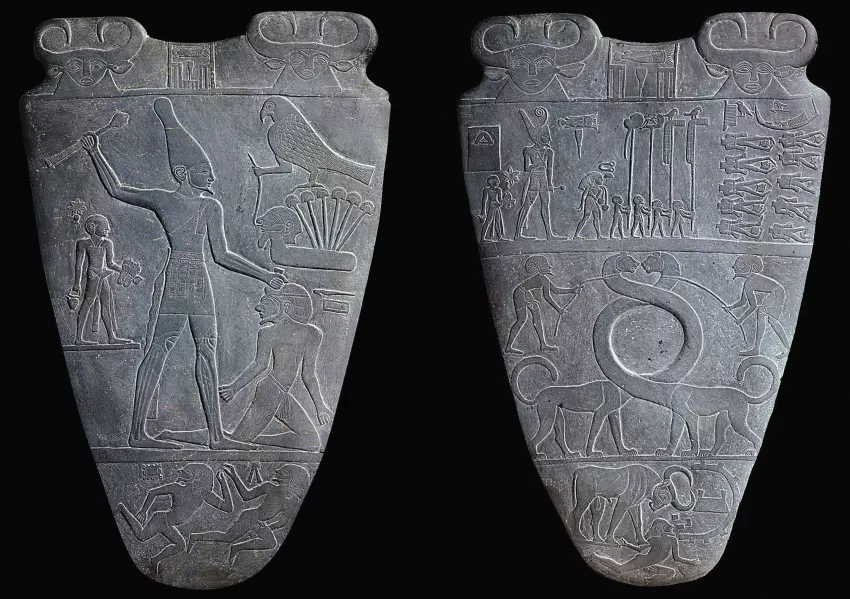
The Narmer Palette, circa 3100 BC, schistous sandstone, 64 x 42 cm, Egyptian Museum, Cairo
The Narmer Palette
Tradition has it that the history of ancient Egypt began with the first dynasty of pharaohs, in 3150 BC. One object bears witness to these early days - the Narmer Palette. It features the pharaoh Narmer who reigned around 3100 BC. The palette was originally used for cosmetic purposes, but later became a commemorative object and thus part of the funerary furniture. Virtually intact, this palette features some of the earliest hieroglyphics in history. King Narmer appears twice on each side, wearing the southern crown of Upper Egypt on one side and the northern crown of Lower Egypt on the other. He was one of the first rulers to unify Egypt.
The Narmer Palette
circa 3100 BC , schistous sandstone , 64 x 42 cm , Egyptian Museum, Cairo , © akg / Bible Land Pictures
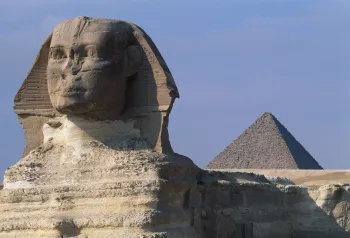
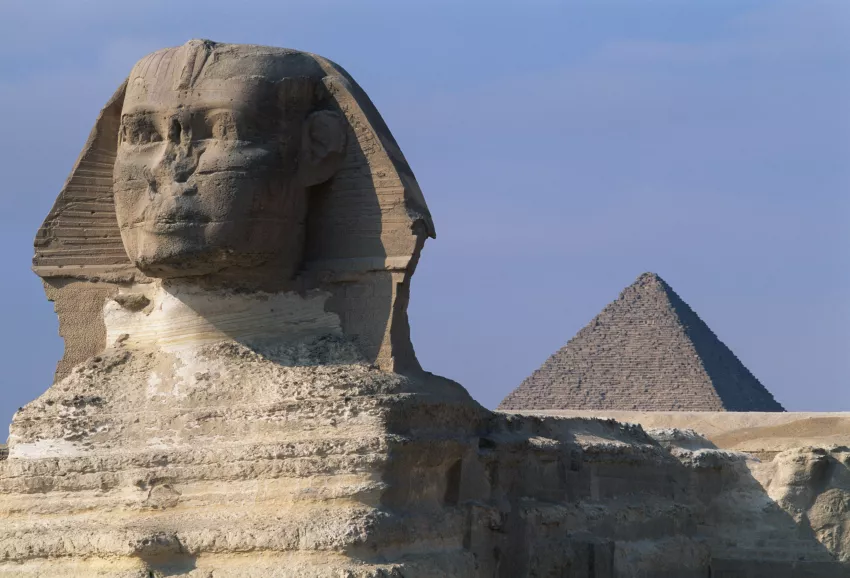
The Sphinx, in the background stands the Pyramid of Menkaure, son of Khafre, circa 2490 BC, Giza
The Sphinx
The kings of Egypt left their mark with spectacular statues. Standing beside the pyramids, with the body of a lion and the face of Pharaoh Khafre, the Sphinx of Giza is a sculpture of superlatives. At 73m long, 14m wide and 20m high, it is the world's largest monolithic statue. Dating from 2500 BC and carved out of the rock, it is believed to have been covered in plaster painted red, blue, and yellow in recent periods of Pharaonic history. Traces of color remain to this day.
The Sphinx, in the background stands the Pyramid of Menkaure, son of Khafre
circa 2490 BC , Giza , © akg-images / De Agostini / V. Giannella
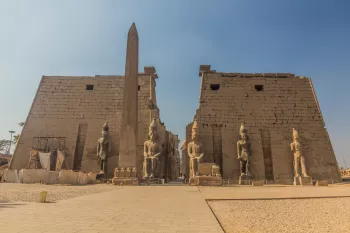
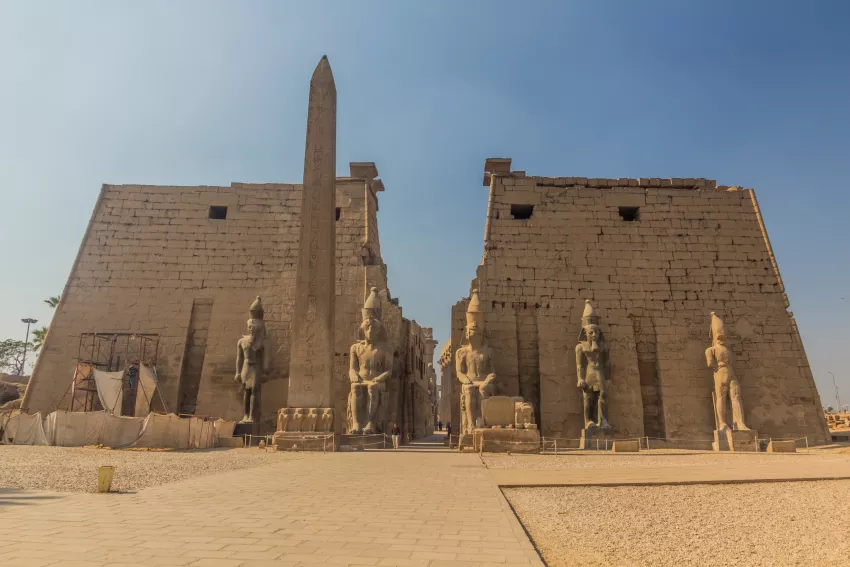
Entrance of the Temple of Luxor, obelisk and colossal statues of Ramesses II, circa 1301-1236 BC, Luxor
Entrance of the Temple of Luxor
At the age of 25, Ramesses II ascended the throne of Egypt around 1300 BC. During his long reign of 67 years, he became one of the most famous pharaohs in history, thanks to the grandiose monuments he built to his glory and marked with his influence. He erected monumental statues of himself in front of the portico of the prestigious Luxor temple in ancient Thebes, even though the temple had been built by his predecessors of the 18th Dynasty. This was not the first time that his megalomania had led him to claim temples and statues for himself, and even to erase the traces of previous pharaohs. In Luxor, he also had two obelisks built, one of which now stands on the Place de la Concorde in Paris, donated in 1830 by the Viceroy of Egypt, Mehemet Ali, to the French King Charles X.
Entrance of the Temple of Luxor
obelisk and colossal statues of Ramesses II , circa 1301-1236 BC , Luxor , © 2022 Matyas Rehak/Shutterstock
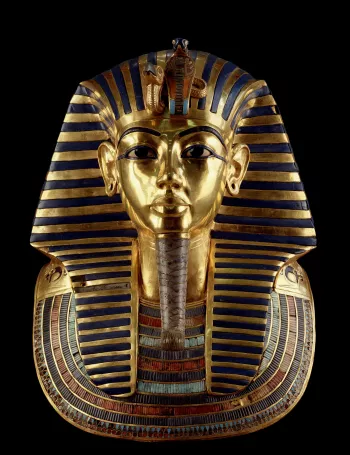

Funerary mask of Tutankhamun (1330-1320 BC), 54 x 39 x 49 cm, gold, silver, copper, inlaid with quartz, obsidian, lapis lazuli, carnelian, amazonite, turquoise and glass paste, 10.32 kg, Grand Egyptian Museum (GEM), Cairo
Funerary mask of Tutankhamun
An absolute masterpiece, Tutankhamun's funerary mask is one of the most emblematic works of Pharaonic art. Placed over the head of his mummy, the funerary mask was protected by a series of chapels and coffins nested like Russian dolls. Made of almost 10 kg of gold and fine stones, the funerary mask is said to represent the face of the pharaoh. Eyes rimmed with kohl, fine facial features, curved hairpiece, symbol of his divinity, pierced ears - the pharaoh fascinates with his ideal androgynous beauty, because... this mask was originally intended for his half-sister and wife Ankhesenamun! The sovereign wears a nemes, a traditional headdress with blue and gold stripes, and an usekh collar of fine stone beads. The headdress is surmounted by the vulture goddess Nekhbet for Upper Egypt, and the cobra goddess Wadjet for Lower Egypt.
Funerary mask of Tutankhamun
1330-1320 BC , gold, silver, copper, inlaid with quartz, obsidian, lapis lazuli, carnelian, amazonite, turquoise and glass paste, 10.32 kg , 54 x 39 x 49 cm , Grand Egyptian Museum (GEM), Cairo , Photo © Andrea Jemolo / Bridgeman Images
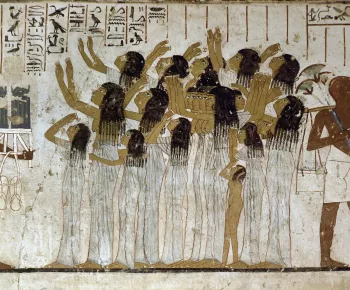

Group of mourners, detail from the mural painting in the tomb of Ramose, circa 1411-1375 BC, Valley of the Nobles, Sheikh 'Abd-el Gournah
Group of mourners
Mourners were either members of the deceased's entourage or professionals paid by the family. They were expected to shout, moan, or chant lamentations during the transport of the remains to make the tribute to the deceased more spectacular. According to the reliefs and paintings, the attitude is always the same: they raise their arms to the sky, imitating the goddesses Isis and Nephthys, who are depicted near the remains of their brother and husband, the god of the underworld Osiris. In this painting, we can see the tears running down the cheeks of the women with their hair down.
Group of mourners
detail from the mural painting in the tomb of Ramose , circa 1411-1375 BC , Valley of the Nobles, Sheikh 'Abd-el Gournah , © akg-images / Erich Lessing


The dead Ani being introduced to Osiris, reproduction of the Papyrus of Ani, circa 1250-1188 BC, 67x42cm, acquired in 1913 by E.A Wallis Budge, British Museum, London
The dead Ani being introduced to Osiris
If the deceased Ani is presented to the god Osiris, it's because he has successfully passed the famous weighing of the heart step. Introduced by the god Anubis, Ani previously appeared before the tribunal presided over by Osiris, before whom he pronounced his declaration of innocence, "I have not committed sins against men (...) I have not committed murder (...) I am pure. I am pure. I am pure". His heart is then placed on a scale, with Maat's feather on the other pan. The goddess of harmony and balance is symbolized by this feather, and the heart of the deceased must be lighter than it. The result of the weighing is, of course, always positive!
The dead Ani being introduced to Osiris
reproduction of the Papyrus of Ani , circa 1295-1188 BC , 67x42cm , acquired in 1913 by E.A Wallis Budge, British Museum, London , © Mary Evans / Bridgeman Images
listen to the playlist of the exhibition
explore more

Download our app
The application, available free of charge on iOS and Android, gives commentaries on the works of our current exhibitions. Discover through original anecdotes 30 major works of the exhibition "Egyptian Pharaohs, From Cheops to Ramses II".
Discover also the exhibitions "From Vermeer to Van Gogh, the Dutch Masters" in Carrières des Lumières (Les Baux-de-Provence) and "Chagall, Paris – New York" in the Hall des Lumières (New York).

